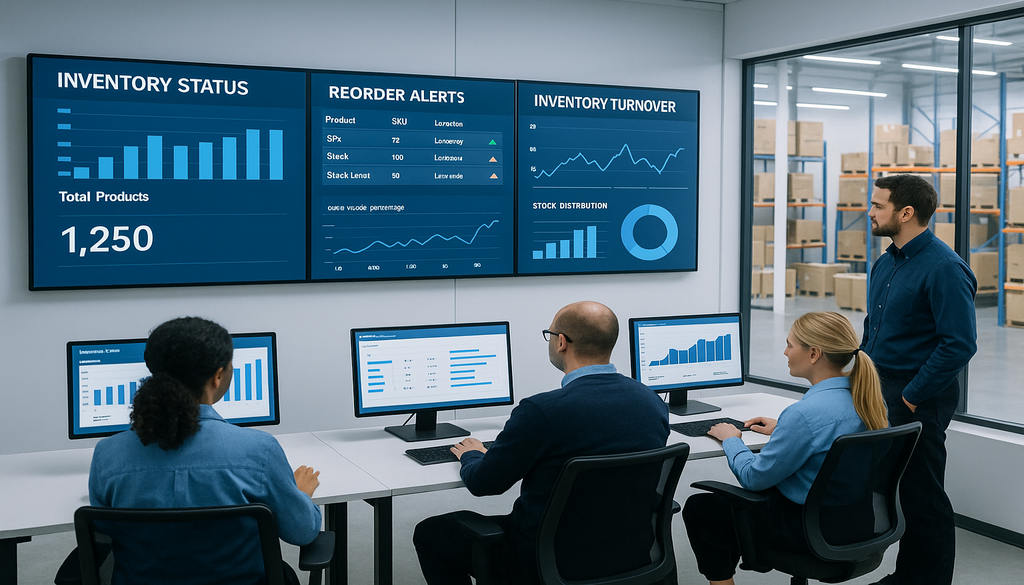Exploring Common Inventory Control Models: A Guide for Warehouse Managers
Inventory control is a cornerstone of effective warehouse management, playing a pivotal role in maintaining optimal stock levels and ensuring smooth operations. As supply chain dynamics become increasingly complex, understanding and implementing the right inventory control models can significantly impact efficiency and cost management. This blog post will explore the most common inventory control models, offering insights into their application in modern warehousing environments. By the end of this guide, you’ll have a clearer understanding of how these models can enhance your warehouse operations.
What is Inventory Control?
Inventory control refers to the systematic approach to sourcing, storing, and selling inventory—both raw materials and finished goods. It is a critical component of supply chain management that ensures a business maintains the right amount of stock to meet customer demand without overstocking or understocking. Effective inventory control directly impacts warehouse efficiency by reducing holding costs, minimizing waste, and improving order fulfillment rates. In essence, it is about striking a balance between supply and demand, which is crucial for maintaining profitability and customer satisfaction.
The Basic Inventory Control Models
First-In, First-Out (FIFO)
The First-In, First-Out (FIFO) model is a straightforward inventory management approach where the oldest inventory items are sold or used first. This method is particularly beneficial for businesses dealing with perishable goods, as it helps prevent spoilage by ensuring that older stock is moved out before newer stock. FIFO is also advantageous for maintaining accurate financial records, as it aligns with the natural flow of inventory and often reflects current market prices more accurately. Typical use cases include food and beverage industries, pharmaceuticals, and any sector where product expiration is a concern.
Last-In, First-Out (LIFO)
In contrast to FIFO, the Last-In, First-Out (LIFO) model prioritizes the sale or use of the most recently acquired inventory. This approach can be effective in industries where inventory costs are rising, as it allows businesses to match current costs against current revenues, potentially reducing taxable income. However, LIFO is less common in practice due to its complexity and the fact that it may not always reflect the actual physical flow of goods. It is most effective in industries dealing with non-perishable items or where inventory costs are highly volatile.
Just-In-Time (JIT)
The Just-In-Time (JIT) inventory model is designed to minimize holding costs by aligning inventory orders closely with production schedules and actual demand. This approach reduces the need for large stockpiles, freeing up warehouse space and reducing waste. JIT is particularly advantageous for businesses with predictable demand patterns and reliable suppliers. It requires precise coordination and real-time data to ensure that inventory arrives exactly when needed, making it ideal for industries like automotive manufacturing and electronics, where components are often assembled on-demand.
Advanced Inventory Control Models
Economic Order Quantity (EOQ)
The Economic Order Quantity (EOQ) model is a mathematical formula used to determine the optimal order quantity that minimizes total inventory costs, including ordering and holding costs. By calculating the ideal order size, businesses can reduce the frequency of orders and the associated administrative costs, while also minimizing the cost of holding excess inventory. EOQ is particularly useful for companies with consistent demand patterns and stable ordering costs. Implementing EOQ requires accurate data on demand rates, ordering costs, and holding costs to ensure the model’s effectiveness.
ABC Analysis
ABC Analysis is a method of categorizing inventory into three categories—A, B, and C—based on their importance and value. Category A items are the most valuable and require the most attention, while Category C items are the least valuable and require less oversight. This model allows businesses to prioritize their resources and focus on managing the most critical inventory items. ABC Analysis is particularly beneficial for companies with a diverse range of products, as it helps identify which items contribute most to overall revenue and require more stringent control measures.
Safety Stock Inventory Model
The Safety Stock Inventory Model involves maintaining a buffer of extra inventory to protect against uncertainties in demand or supply chain disruptions. Determining the right level of safety stock is crucial to prevent stockouts and ensure smooth operations. This model is especially important for businesses with fluctuating demand patterns or those that rely on long lead times from suppliers. By analyzing historical data and demand forecasts, companies can calculate the appropriate safety stock levels to maintain service levels without incurring excessive holding costs.
Integrating Inventory Control Systems
Technology plays a crucial role in enhancing traditional inventory control models, offering tools that provide real-time data and analytics to improve decision-making. Modern inventory control software can automate many aspects of inventory management, from tracking stock levels to generating reorder alerts. Key features to look for in inventory control software include integration capabilities with existing systems, user-friendly interfaces, and robust reporting tools. Real-time data is essential for accurate demand forecasting and inventory optimization, allowing businesses to respond quickly to changes in market conditions and customer demand.
Challenges in Implementing Inventory Control Models
Implementing inventory control models is not without its challenges. Common obstacles include resistance to change, lack of accurate data, and integration issues with existing systems. Overcoming these challenges requires a strategic approach, including thorough training for staff, investing in reliable technology, and establishing clear communication channels across departments. Learning from industry leaders can provide valuable insights into best practices and potential pitfalls. For instance, companies like Amazon have successfully implemented sophisticated inventory control systems that leverage technology and data analytics to optimize their supply chain operations.
Future Trends in Inventory Control
The future of inventory control is being shaped by advancements in predictive analytics and a growing emphasis on sustainability. Predictive analytics allows businesses to anticipate demand more accurately, reducing the risk of overstocking or stockouts. This technology is becoming increasingly accessible, enabling even small businesses to leverage data for improved inventory management. Additionally, sustainability is becoming a key consideration in inventory practices, with companies seeking ways to reduce waste and minimize their environmental footprint. This trend is driving the adoption of more efficient inventory models and practices that align with corporate social responsibility goals.
Conclusion
In conclusion, understanding and implementing the right inventory control models is essential for optimizing warehouse operations and meeting the evolving demands of the supply chain industry. From basic models like FIFO and LIFO to advanced approaches such as EOQ and ABC Analysis, each model offers unique benefits and challenges. By integrating technology and staying informed about industry trends, warehouse managers can enhance their inventory management strategies and drive operational efficiency. As the industry continues to evolve, staying adaptable and informed will be key to maintaining a competitive edge.
Frequently Asked Questions (FAQ)
Q1: What is the most cost-effective inventory control model for small businesses?
A1: The JIT model can be highly cost-effective for small businesses, as it minimizes holding costs by aligning inventory orders closely with production schedules and demand. This approach reduces the need for large stockpiles, freeing up capital and warehouse space, which is particularly beneficial for businesses with limited resources.
Q2: How does inventory control software improve model accuracy?
A2: Inventory control software provides real-time data and analytics, improving the accuracy of demand forecasting and order quantity calculations. By offering insights into sales trends and inventory levels, the software enhances the overall efficiency of inventory models, enabling businesses to make informed decisions and reduce the risk of stockouts or overstocking.
Q3: Can multiple inventory control models be used simultaneously?
A3: Yes, businesses often combine different models to cater to various product types and demand patterns, optimizing overall inventory management. For example, a company might use JIT for fast-moving items while applying EOQ for products with stable demand, ensuring a balanced approach to inventory control.
Q4: What are the first steps in implementing an inventory control system in a new warehouse?
A4: The first steps include assessing current inventory needs, selecting appropriate control models, and choosing the right software tools to support these models. It’s crucial to establish clear processes and train staff to ensure a smooth transition. Additionally, setting measurable goals and regularly reviewing performance can help refine the system over time.
Q5: How often should inventory control models be reviewed or updated?
A5: Inventory control models should be reviewed annually or whenever significant changes in production or market demand occur, ensuring they remain aligned with business needs. Regular reviews help identify areas for improvement and adapt strategies to changing market conditions, maintaining optimal inventory levels and operational efficiency.
{
“@context”: “https://schema.org”,
“@type”: “FAQPage”,
“mainEntity”: [
{
“@type”: “Question”,
“name”: “Q1: What is the most cost-effective inventory control model for small businesses?”,
“acceptedAnswer”: {
“@type”: “Answer”,
“text”: “The JIT model can be highly cost-effective for small businesses, as it minimizes holding costs by aligning inventory orders closely with production schedules and demand. This approach reduces the need for large stockpiles, freeing up capital and warehouse space, which is particularly beneficial for businesses with limited resources.”
}
},
{
“@type”: “Question”,
“name”: “Q2: How does inventory control software improve model accuracy?”,
“acceptedAnswer”: {
“@type”: “Answer”,
“text”: “Inventory control software provides real-time data and analytics, improving the accuracy of demand forecasting and order quantity calculations. By offering insights into sales trends and inventory levels, the software enhances the overall efficiency of inventory models, enabling businesses to make informed decisions and reduce the risk of stockouts or overstocking.”
}
},
{
“@type”: “Question”,
“name”: “Q3: Can multiple inventory control models be used simultaneously?”,
“acceptedAnswer”: {
“@type”: “Answer”,
“text”: “Yes, businesses often combine different models to cater to various product types and demand patterns, optimizing overall inventory management. For example, a company might use JIT for fast-moving items while applying EOQ for products with stable demand, ensuring a balanced approach to inventory control.”
}
},
{
“@type”: “Question”,
“name”: “Q4: What are the first steps in implementing an inventory control system in a new warehouse?”,
“acceptedAnswer”: {
“@type”: “Answer”,
“text”: “The first steps include assessing current inventory needs, selecting appropriate control models, and choosing the right software tools to support these models. It’s crucial to establish clear processes and train staff to ensure a smooth transition. Additionally, setting measurable goals and regularly reviewing performance can help refine the system over time.”
}
},
{
“@type”: “Question”,
“name”: “Q5: How often should inventory control models be reviewed or updated?”,
“acceptedAnswer”: {
“@type”: “Answer”,
“text”: “Inventory control models should be reviewed annually or whenever significant changes in production or market demand occur, ensuring they remain aligned with business needs. Regular reviews help identify areas for improvement and adapt strategies to changing market conditions, maintaining optimal inventory levels and operational efficiency.”
}
}
]
}










